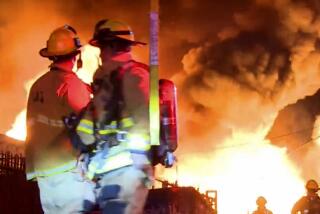Arsonist Guilty of Murder
An arson-investigator-turned-arsonist was convicted Friday on four counts of first-degree murder, making him eligible for the death penalty for setting a South Pasadena hardware store blaze in 1984 that matched in chilling detail a fire he described in an unpublished novel.
John Leonard Orr, once a captain in the Glendale Fire Department, slumped forward as the verdicts were read in Los Angeles Superior Court. He was found guilty of two dozen felonies, including 20 counts stemming from a string of fires he set in Glendale and La Canada Flintridge in 1990-91.
Those counts included the devastating firestorm that damaged or destroyed 67 homes in the College Hills section of Glendale in June 1990. The jury acquitted him of setting a fire on the Warner Bros. lot in Burbank that destroyed the set of the 1970s television show âThe Waltons.â
Orr was convicted in 1992 of federal arson charges stemming from a series of San Joaquin Valley hardware store blazes. In 1993, he pleaded guilty to setting three other blazes, including a 1990 fire at a Builders Emporium in North Hollywood and two more near Atascadero in 1989. He was serving a 30-year federal prison sentence before his trial on state charges began.
The penalty phase of the state trial begins Monday, when the prosecution will seek a death sentence because four people--including a 2-year-old boy--died when fire swept Oleâs Home Center in South Pasadena on Oct. 10, 1984.
Deputy Dist. Attys. Michael Cabral and Sandra Flannery would not comment on the verdicts, citing a gag order imposed at the start of the trial by Superior Court Judge Robert J. Perry. Before the trial began, however, they said that in any penalty phase they would introduce evidence that Orr was involved in as many as 40 other fires.
During the five-week trial, prosecutors presented evidence that Orr engaged in a pattern of criminal behavior--setting fires during the day in plastic foam materials in the back of occupied businesses by using a âsignatureâ time-delay device made from a cigarette, matches, a rubber band and yellow legal paper.
Also introduced was âPoints of Origin,â a manuscript Orr wrote detailing the activities of a firefighter who is secretly an arsonist and âfavors large brush fires but graduates to burning businesses.â
In the manuscript, the protagonist, Aaron, uses a slow-burning incendiary device to set fire to a Pasadena hardware store called Calâs. That blaze kills several employees, as well as a woman and her young grandson.
The Oleâs fire killed store employees Carolyn Kraus, 26, and Jimmy Cetina, 17, and customer Ada Deal, 50, and her 2-year-old grandson, Matthew Troidl.
Orr wrote in his manuscript: âThe investigating agency termed . . . [another] fire arson, but no correlation was made to the Calâs fire.â Aaron, the writer continued, âwanted the Calâs fire to be called arson. He loved the inadvertent attention he derived from the newspaper coverage and hated it when he wasnât properly recognized.â
Pitching his work in a 1991 letter to the L. Harry Lee Literary Agency, Orr called the narrative a âfact-basedâ story that âfollows the pattern of an actual arsonist that has been setting serial fires in California over the past eight years. He has not been identified or apprehended, and probably will not be in the near future.â
Defense attorneys Edward Rucker and Peter Giannini countered that there was no physical evidence linking their client to the fires. They called the manuscript âpure fiction,â comparing it to the 1991 movie âBackdraft,â which also was written by a firefighter.
The defense case was built around testimony by four arson investigators--from the Los Angeles County Fire Department and Sheriffâs Department--that the Oleâs blaze was caused by faulty wiring in the ceiling. The defense team also cited a wrongful-death case in which the families of the Oleâs fire victims collected millions of dollars after the jury determined that the blaze was electrically caused.
Orr became a suspect after federal investigators found his fingerprint on burned yellow legal paper at the scene of a San Joaquin Valley fire. They began tracking his movements to several fire scenes, and when he was arrested at his Eagle Rock home, authorities recovered a briefcase containing cigarettes, rubber bands, matches, rocks, paper bags, incense sticks and cigarette lighters.
The trialâs most dramatic moment came when Cabral read a chapter from âPoints of Originâ detailing the final moments of the hardware store victims:
âThe last thing she heard was a tremendous roar as the fire burned through the roof and vented to the outside,â Cabral read. âThe smoke momentarily lifted but was then replaced by solid fire as the entire contents of the annex exploded into flames. Their last breaths were of 800-degree heat that seared their throats closed.â
In pleading guilty in 1993 to the federal charges that included the North Hollywood hardware store fire, Cabral said, Orr had in effect âsaid under oath, âI did the crime that is described in my book, and it was done in a strikingly similar fashion to what I described in my book.â â
More to Read
Sign up for Essential California
The most important California stories and recommendations in your inbox every morning.
You may occasionally receive promotional content from the Los Angeles Times.










